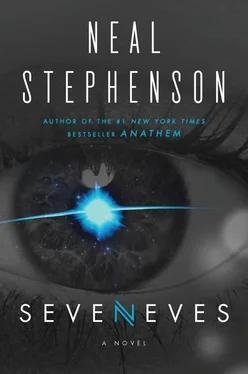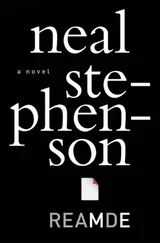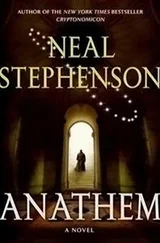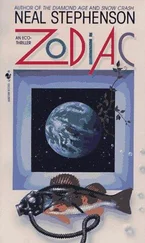“What do you know about the Kulak?”
“What any civilian lacking a security clearance would know,” Ty answered carefully. “People are assumed to be living in the fist part of it.”
“Kulak” was Russian for “fist.” In this context it denoted an irregular lump of nickel-iron some thirty kilometers across. A hundred and fifty years ago, Red had moved it from the Kamchatka boneyard to a position above the Makassar Strait, where it had orbited ever since. Like a loosely clenched fist, it had a cavity down the middle, a tunnel now presumed to be lined with rotating habitats. Red’s answer to the Great Chain.
“Then there’s the rigging and spars whatnot surrounding that,” Ty went on. For the fist, viewed from a distance, seemed to be tangled in a sparse web of cables, like a seed in a spiderweb. Above and below — to the nadir and zenith sides — these converged on hard points to which the long cables extending down to Earth’s surface and up to the counterweight — the Antimakassar — were attached.
Sonar Taxlaw, a few meters away, had been engaged in a public display of affection with Einstein, but withdrew slightly and turned her head to listen.
Ty had grown accustomed to her ways. It was because he had said “spars.” That was between Sonar and Taxlaw in the Encyclopædia Britannica, and thus belonged to her domain of knowledge. During their hike over the mountains and down the other side, she had turned out to be well informed, at least by troglodyte standards, about space exploration and the sun. So it had been easy to bring her up to speed on the last five thousand years’ off-planet developments. She now began to drift toward Ty. Einstein followed her as if his eyes were connected to her butt cheeks with fishhooks.
Oblivious to all this — for he had his back to it — Arjun was regarding him coolly, expecting more. Ty went on: “The part on the surface — their answer to Cradle — we don’t know much about. They’ve been building it under the sea.”
“They call it the Gnomon,” Arjun informed him. Then he spelled the word out.
“What does it mean?”
“It used to be the thing that stood up in the middle of a sundial, to cast the shadow. Aligned with the Earth’s axis.”
Ty considered it. “Interesting choice of words.”
“It’s big, Ty. Much bigger than Cradle. There’s a reason they’ve been building it in the ocean. Partly to hide it from us. And partly because it’s too large to construct on terra firma.”
“How big are we talking about exactly?”
“There is only so much I’m at liberty to say,” Arjun said. Then he drew out a tablet and began tapping at it, pulling up a world map, panning and zooming toward the mess of islands between Southeast Asia and Australia. “But just look at this and tell me what you see.” He handed it to Ty.
“Southeast Asia!” exclaimed the Cyc, who had drawn close enough to see all of this over Arjun’s shoulder. “Is there anything you would care to know of it? Or of Sulawesi? Or of Sri Lanka?”
The Ivyn regarded her with fascination.
“I don’t need to look,” Ty said. “I know what’s there. The equator runs through all of that and rarely crosses over the land, and Red never stops whining about it.”
“Not true! Sumatra. .” said the Cyc.
“A big island to be sure,” Ty said, “but not a continent. Do you remember, Sonar, what I told you about how the Eye works? What Cradle does?”
“Touches the equator,” she returned.
“And only the equator. Which is great if you control Africa and South America. Which Blue does. But most of Red’s territory lies north or south of the line.”
Sonar wasn’t going to be talked down so easily. “Singapore is close,” she said, “and that is connected to Asia.”
“The former location of Singapore is close, yes. But not on the equator. It’s one or two degrees north. Cradle can’t dock there.”
“And that one detail, more than anything else, is what infuriated the Aïdans about the design of the Eye and Cradle,” Arjun put in.
Sensing Einstein behind her, the Cyc leaned comfortably back against him and started rattling off facts — her default mode of social interaction. “Aïdans,” she said. “The ABC hierarchy. Aretaics, Betas, Camites.”
“Camites are a different race,” Einstein reminded her.
“Oh yeah. The relationship of the A and the B to the C is more akin to Symbiosis.”
Ty and Einstein exchanged a wry look.
Oblivious, Sonar Taxlaw gazed down the hill toward Langobard. “Neoanders. And two more. The smart ones and the crazy ones.”
“Jinns and Extats,” Einstein said. “They don’t get out much.”
Arjun’s fascination with seeing a rootstock human had given way to impatience. He focused on Ty again. “This is old history, of course,” he said, “but never forgotten by some people. Way back when the Eye was being designed — I’m talking a thousand years ago — there were alternative schemes proposed. The one we ended up with was simplest, easiest to build with what people had back then. The Eye, the Big Rock, and a small Cradle with sockets on the equator. Great for access to South America and Africa. Almost useless, however, in the stretch of the equator under the habitats where Aïdans, half of the Camites, and most of the Julians lived.”
“What later became Red,” Einstein put in, for Sonar Taxlaw’s benefit.
“One of the reasons Red later coalesced, and built such a strong counteridentity to Blue, was their sense of grievance over this decision. We should have waited, they said. We could have had something much more useful than Cradle.” Arjun zoomed in on Indonesia and dragged out a skinny rectangle, straddling the equator and spanning most of Red’s latitudes. “If instead of Cradle we had made something in the shape of a long arc, spanning a greater distance north-south, it might have connected with Asia down here, where Singapore used to be. And here it could touch the northern cape of New Guinea. And New Guinea could be connected to Australia by dropping enough rocks into the shallows between them.”
“A long arc. Aligned with the Earth’s axis, casting a shadow on the ground,” Ty said, nodding. “A Gnomon.”
“It would have to be huge!” Einstein exclaimed.
Arjun nodded. “Plans for it were drawn up. Studies commissioned on how it might be constructed, in orbit or on the surface. It was deemed too ambitious. So wiser heads prevailed,” said Arjun, “or so it seemed at the time, and we built what we built. We can always make something bigger later, they said. But it didn’t turn out that way. Blue forgot about it. Red didn’t. Their Jinns put as much effort into thinking about it as our Ivyns put into epigenetics. As soon as they closed the border and put up the two turnpikes, they went to work. What have they been doing that whole time?”
“Smiting the Torres Strait with an unceasing storm of bolides,” said Sonar Taxlaw, pointing to the narrows where Australia’s northern cape almost poked New Guinea in the belly. “Filling it in. Damming the currents. Making a wall against those that swim in the sea.”
Arjun nodded.
Then his head snapped around to focus on the Cyc.
He stared at her intently for a moment, then looked at Ty. “Did you. .” he began.
“Not a word,” Ty said.
“Einstein, did you tell her about Red’s illegal terraforming operation here?” And he tapped the same place on the map.
“First I’ve heard of it,” Einstein said.
“Sonar,” Arjun said, “how did you know about that?”
“The Pingers told us,” Sonar said.
“Who the hell are the Pingers?”
“The people we are going to talk to,” Sonar said.
Читать дальше
Конец ознакомительного отрывка
Купить книгу





